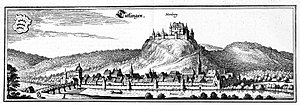Battle of Tuttlingen
| date | November 24, 1643 |
|---|---|
| place | Surroundings of Tuttlingen am Honberg |
| output | Victory of the imperial / Bavarian troops |
| consequences | Withdrawal of France |
| Parties to the conflict | |
|---|---|
|
Bavaria / Empire |
France |
| Commander | |
|
Franz von Mercy |
|
| losses | |
|
6-7,000 prisoners |
|
Wallerfangen - Dömitz - Haselünne - Wittstock - Rheinfelden siege - Rheinfelden battle - Breisach Siege - Witten Weiher - Vlotho - Ochsenfeld - Chemnitz - Bautzen siege - Freiberg sieges - Riebel Dorfer Mountain - Dorsten - Preßnitz - La Marfée - Wolfenbüttel siege - Kempen Heath - Swidnica - Breitenfeld - Klingenthal - Tuttlingen - Freiburg - Jüterbog - Jankau - Herbsthausen - Alerheim - Korneuburg - Totenhöhe - Hohentübingen - Triebl - Zusmarshausen - Wevelinghoven - Dachau - Prague siege
The battle of Tuttlingen in November 1643 was a skirmish between the allied imperial and Bavarian troops and the Franco- Weimar army in the Thirty Years' War . The French army was largely destroyed by a nightly raid by the Imperialists.
course
On November 24, 1643, Bavarian and imperial troops (supplemented, among other things, by Lorraine and Spanish units) under Franz von Mercy , Count Melchior von Hatzfeldt , Johann von Werth and Duke Karl IV of Lorraine surprised the French army, which was in the vicinity of Tuttlingen was in winter quarters. The French had established their headquarters in the ruins of Honberg Castle and in the city, and the artillery and cannons were stored in the cemetery in between . That turned out to be a gross mistake. Heavy snowfall made it possible for the imperial cavalry to proceed almost silently with 1,500 horsemen under von Werth and Johann von Sporck and a dragoon regiment under Colonel Gold and a hundred Croatian cavalry under the then Colonel and later General Georg von Truckmüller. The guards of the French artillery were taken completely unprepared by the attack, so that an orderly defense was not possible. The French cavalry managed to escape. The rest of the French army, which was billeted in the area, was unable to break away from the enemy. The Honberg was taken without Allied losses because the enemy lacked his cannons.
The following day the remaining troops surrendered, including the French commander-in-chief Josias Rantzau , and seven of his generals. Of the original 15,000 men in the French army, 4,500 had escaped and 4,000 had died. Almost 7,000 were taken prisoner, including 260 officers with 8 generals and 9 colonels. The booty also included all the cannons with 560 horses, silver dishes and the cash to pay the army for a month.
The “entanglement of the stucco and wagons, so received by the enemy” lists: “2 half carthaunas, 2 associated lauettes. 1 singer. 2 snakes. 4 short falcons in years lauetten. 1 Pöller with his lauettes. 32 ammunition carts. 20 ball carts. 13 karrn. "
consequences
After the catastrophic outcome of the battle of Tuttlingen, the situation for the French army in Württemberg became untenable. The retreat across the Rhine had to take place in winter and most of the soldiers and material were lost through hunger, cold and desertion. After the great victory in the Battle of Rocroi in May of the same year, the defeat at Tuttlingen did not fit into the image of the leadership of France under Mazarin and was therefore kept secret for a long time, although the defeat threw the military situation for France back to the state it was five years ago.
literature
- Friedemann Needy : Pocket Lexicon Thirty Years War , Munich 1999.
- Rainer Knörle: The Württemberg south festivals Honberg , Tuttlinger Heimatblätter 61, 7–26 (1998).
- Jens Florian Ebert: The battle of Tuttlingen on November 24, 1643. Causes, history and course , Tuttlinger Heimatblätter NF 74 (2001) pp. 43-80.
Individual evidence
- ^ A b Christian Pantle: The Thirty Years' War. When Germany was on fire . Propylaen Ullstein Buchverlage GmbH, Berlin 2017, ISBN 978-3-549-07443-5 , p. 267-270 .
- ↑ The Battle of Tuttlingen on Tuttlinger Heimatblätter
